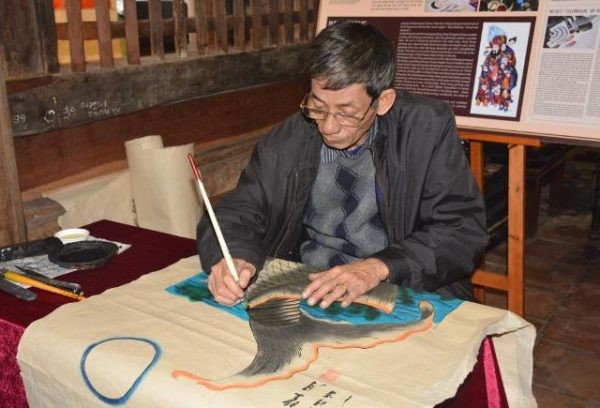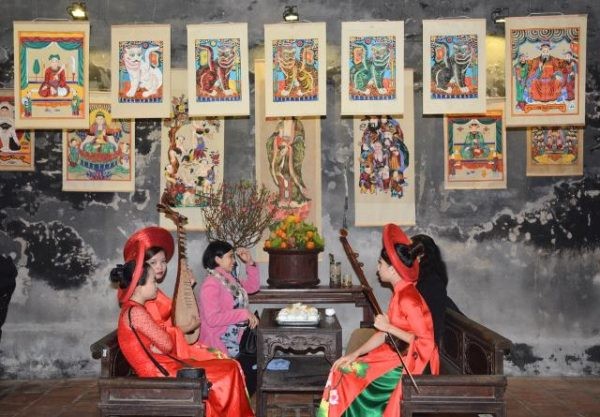The folk paintings of Hang Trong were once famous in the Capital city, at the moment, Mr. Le Dinh Nghien – the sole artisan of the folk painting of Hang Trong is still wholeheartedly devoting himself to the craft, conservation and passing it onto successors.
The painting of “ A carp ẹnjoy moonlight” is being completed under the dexterious hands of artisan Le Dinh Nghien.
The beginning of the XX century was considered as the heyday of the Hang Trong folk painting type. During that peiod, Hang Trong paintings were made by many families living in Hang Non (Conical making street), Hang Quat (Fan making street), Hang Hom (Case making street),.., but it was still called Hang Trong paintings as they were almost produced in this street area.

The painting of “ A carp ẹnjoy moonlight” is being completed under the dexterious hands of artisan Le Dinh Nghien.
Hang Trong painting belongs to two main types, one is for worship and the other is for Tet. According to researchers, Hang Trong painting originates from the religious painting, as a result of the intertwining creams between Bhuddism and Confucianism; between the worship statue, carvings in temples or pagodas and finenesses in the daily cultural life. Hang Trong painting owns delicate and smooth features, newly fresh and lively colours and broad-minded portraying. Due to it is made from dark yellow materials of plant paper, as long as it is kept it looks as old as it is.
Hang Trong painting is wellknown for the painting types as “Happiness, wealth and longevity”; having many kids to maintain the continuity of a family line titled as mang tên “Seven children”, “Children are for ever”; story painting and funny paintaing like “Mouse homeward bound”, “toad scholar”, “Kieu story”; mundane life and natural paintings “Countryside fair”, “Peacock”, “A carp enjoys moonlight”, “Four seasons”, “ A beautiful woman”…
It was such an prosperous time. Yet, up till now, it is only artisan Le Dinh Nghien who is remaining to be associated with the type of Hang Trong folk painting and maintaining the craft. He also is still keeping the techniques of making paintings in the way of old carved board used since the last century.

Hang Trong paintings on display at Kim Ngan Temple, Hang Bac Street, Ha Noi.
Hang Trong painting is printed by wooden carved board on the plant paper. When doing this, painters use pen brushes to dip in the colours and, depending on the picture’s contents and features as well as its type, to draw patches of light and dark colour. Next is the process of painting consolidation, an important step in completing the work. Sharing this, artisan Le Dinh Nghien pointed out the success and long-standing existence of a work is up to this process, as this requires skills of the artisan. Due to by-hand colouring, each painting has become an exclusive creation of the artisan.
For those who love folk painting are often dropping by Cua Dong street to see the only left artisan of this type of folk painting. Artisan Le Dinh Nghien is of the third generation in the family that traditionally possesses the craft of making paintings in Binh Vong village, Thuong Tin (former Ha Tay province), but now that is being settled down in Hang Trong street, Ha Noi. Out of 7 children, has only he had been following his ancestors’ footstep.
Mr. Le Dinh Nghien went on further that I am old now, and I myself have managed to inherit this trade from my forefathers, I will keep working when I am still fine. However, I am a bit concerned about how to relay it to the future generation. At present, his son is continuing his career, however with a small number of successors, he is afraid that this type of painting will sink into oblivion.
“When I am getting weaker, I hope that my childen and grand children will take over it from the predecessors, continuing to preserve the original carved boards left from generation to generation.” He added.
By Hoa An

